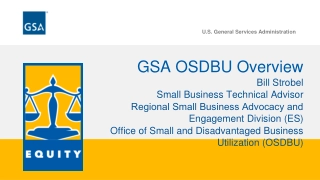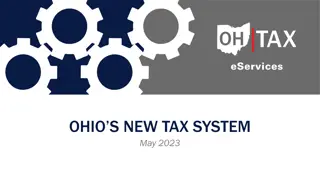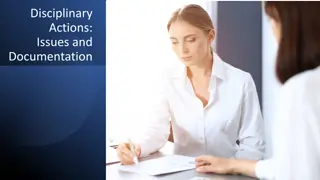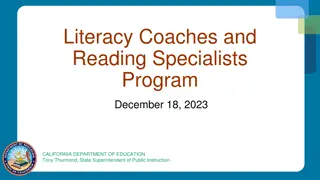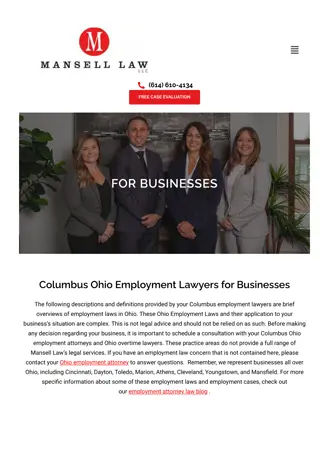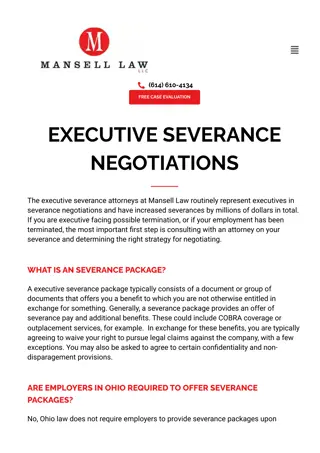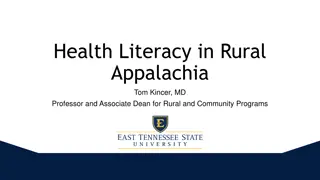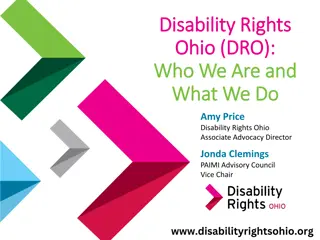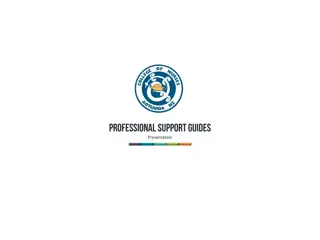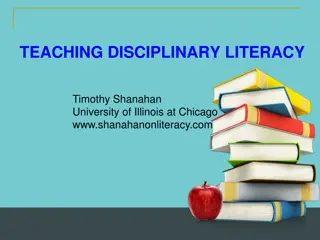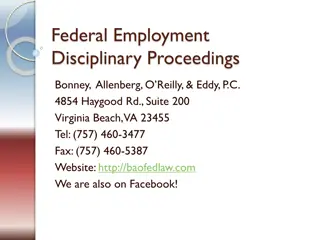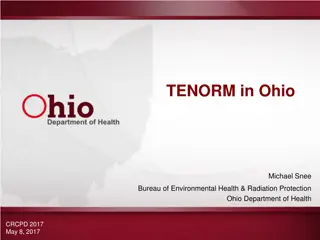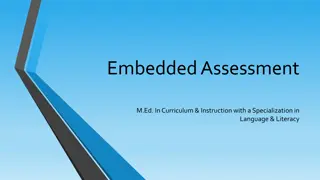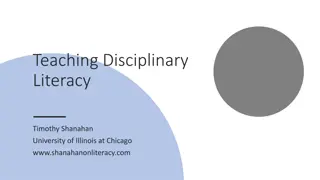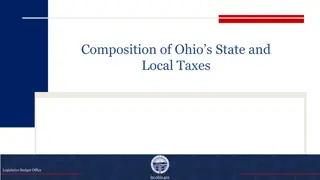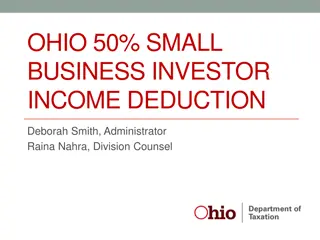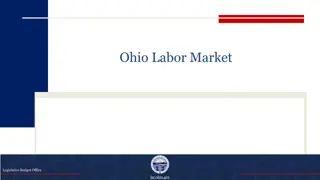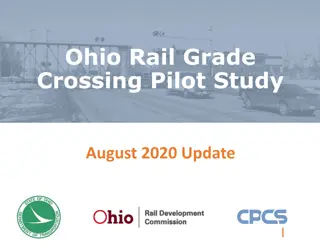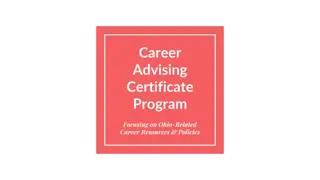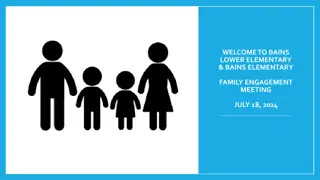
Specialized Reading and Writing in Disciplinary Literacy
Disciplinary literacy involves specialized reading and writing methods across disciplines such as mathematics, science, history, and literature. Education systems are adapting to prepare students for handling distinct texts and thinking like specialists, emphasizing analysis of primary and secondary sources, interpretation of events, and evaluation of authors' perspectives.
Download Presentation

Please find below an Image/Link to download the presentation.
The content on the website is provided AS IS for your information and personal use only. It may not be sold, licensed, or shared on other websites without obtaining consent from the author. If you encounter any issues during the download, it is possible that the publisher has removed the file from their server.
You are allowed to download the files provided on this website for personal or commercial use, subject to the condition that they are used lawfully. All files are the property of their respective owners.
The content on the website is provided AS IS for your information and personal use only. It may not be sold, licensed, or shared on other websites without obtaining consent from the author.
E N D
Presentation Transcript
DISCIPLINARY LITERACY Disciplinary literacy is a term used to refer to the unique or highly specialized ways that reading and writing are used in the various disciplines Mathematicians, scientists, historians, and literary critics create, disseminate, and evaluate knowledge differently and, consequently, the texts they create are different Secondary schools are now required to help their students deal with these specialized text and to read and write like the specialists in those fields Elementary teachers have no such responsibility, but can do a lot to help prepare kids for later success
HISTORY AND SOCIAL STUDIES STANDARDS CIte specific textual evidence to support analysis of primary and secondary sources, attending to such features as the date and origin of the information. Analyze in detail a series of events described in a text and the causes that link the events; distinguish whether earlier events caused later ones or simply preceded them. Identify aspects of a text that reveal an author s point of view or purpose (e.g., loaded language, inclusion or avoidance of particular facts). Compare the point of view of two or more authors by comparing how they treat the same or similar historical topics, including which details they include and emphasize in their respective accounts. Interpret the meaning of words and phrases in a text, including how an author uses and refines the meaning of a key term over the course of a text (e.g., how Madison defines faction in federalist no. 10 and no. 51). Evaluate authors differing points of view on the same historical event or issue by assessing the authors claims, evidence, and reasoning. .
HISTORY & SOCIAL STUDIES STANDARDS (CONT.) Distinguish among fact, opinion, and reasoned judgment in a historical account. Compare and contrast treatments of the same topic in several primary and secondary sources. Evaluate an author s premises, claims, and evidence by corroborating or challenging them with other sources of information. Integrate information from diverse sources, both primary and secondary, into a coherent understanding of an idea or event, noting discrepancies among sources. Distinguish among facts, reasoned judgment based on research findings, and speculation in a text. Follow precisely a complex multistep procedure when carrying out experiments, taking measurements, or performing technical tasks, attending to special cases or exceptions defined in the text. .
SCIENCE & TECHNICAL SUBJECTS STANDARDS Determine the meaning of symbols, key terms, and other domain- specific words and phrases as they are used in a specific scientific or technical texts and topics. Integrate quantitative or technical information expressed in words in a text with a version of that information expressed visually (e.G., In a flowchart, diagram, model, graph, or table). Distinguish among facts, reasoned judgment based on research findings, and speculation in a text. Follow precisely a complex multistep procedure when carrying out experiments, taking measurements, or performing technical tasks, attending to special cases or exceptions defined in the text.
SCIENCE & TECHNICAL SUBJECTS STANDARDS Analyze the structure of the relationships among concepts in a text, including relationships among key terms (e.G., Force, friction, reaction force, energy). Translate quantitative or technical information expressed in words in a text into visual form (e.G., A table or chart) and translate information expressed visually or mathematically (e.G., In an equation) into words. Compare and contrast findings presented in a text to those from other sources (including their own experiments), noting when the findings support or contradict previous explanations or accounts.
SCIENCE & TECHNICAL SUBJECTS STANDARDS (CONT.) Cite specific textual evidence to support analysis of science and technical texts, attending to important distinctions the author makes and to any gaps or inconsistencies in the account. Follow precisely a complex multistep procedure when carrying out experiments, taking measurements, or performing technical tasks; analyze the specific results based on explanations in the text. Synthesize information from a range of sources (e.G., Texts, experiments, simulations) into a coherent understanding of a process, phenomenon, or concept, resolving conflicting information when possible.
LITERATURE STANDARDS Determine two or more themes or central ideas of a text and analyze their development over the course of the text, including how they interact and build on one another to produce a complex account; provide an objective summary of the text. Analyze the impact of the author s choices regarding how to develop and relate elements of a story or drama (e.G., Where a story is set, how the action is ordered, how the characters are introduced and developed). Determine the meaning of words and phrases as they are used in the text, including figurative and connotative meanings; analyze the impact of specific word choices on meaning and tone, including words with multiple meanings or language that is particularly fresh, engaging, or beautiful. (Include Shakespeare as well as other authors.)
LITERATURE STANDARDS Analyze a case in which grasping a point of view requires distinguishing what is directly stated in a text from what is really meant (e.G., Satire, sarcasm, irony, or understatement). Analyze multiple interpretations of a story, drama, or poem (e.G., Recorded or live production of a play or recorded novel or poetry), evaluating how each version interprets the source text. (Include at least one play by shakespeare and one play by an american dramatist.) Demonstrate knowledge of eighteenth-, nineteenth- and early- twentieth-century foundational works of american literature, including how two or more texts from the same period treat similar themes or topics.
DISCIPLINARY LITERACY (CONT.) Elementary teachers are not responsible for teaching disciplinary literacy But they do have a responsibility for preparing students to eventually succeed with such standards
1. BUILD BASIC SKILLS Phonemic awareness instruction ensures that children can perceive sounds within words, hold them in memory, and operate on them Phonics instruction enables children to translate letters and spelling patterns into sounds and pronunciations (translating written to oral language) Oral reading fluency instruction supports children s ability to decode accurately and with sufficient speed to make sense of text Reading comprehension instruction guides students to expect text to be meaningful and to think in ways, while reading, that support understanding and recall
PHONOLOGICAL AWARENESS PA is the ability to detect, manipulate, or analyze the auditory aspects of spoken language independent of meaning (e.g., word separations, syllables, rhymes, phonemes) Instruction aims to teach students to perceive the sounds in spoken words (full segmentation) Students can be taught to perceive the phonemes in spoken words in preschool, kindergarten, and grade 1 and this has a positive impact on learning to read (Adams, 1990; National Reading Panel, 2000; National Early Literacy Panel, 2008)
DECODING English is an alphabetic language that means word construction (the spelling of words) represents oral sounds, not meanings Decoding instruction teaches students to use the sounds of letters and the pronunciations of spelling patterns to decode words (without reliance on context, pictures, guessing) and to spell words Research shows that explicit and systematic decoding instruction in preschool, kindergarten, and Grades 1-2 leads to improved word reading, oral reading fluency, spelling, and reading comprehension (Adams, 1990; National Reading Panel, 2000; National Early Literacy Panel, 2008)
ORAL READING FLUENCY Oral reading fluency refers to the ability to read text accurately, with sufficient speed, and proper expression Oral reading fluency instruction focuses on repeated oral reading of challenging texts with feedback Research shows that oral reading fluency instruction in grades 1-4, and with struggling readers in grades 1-2 improves word reading, oral reading fluency, and reading comprehension (National Reading Panel, 2000; Kuhn & Stahl, 2003)
VOCABULARY Vocabulary refers to knowing the meanings of words (or of the meaningful parts of words) Vocabulary instruction teaches students the meanings of specific words and word parts, how to use context to infer word meanings, and how to use references like dictionaries Research shows that vocabulary instruction throughout the grades improves reading comprehension (National Reading Panel, 2000)
COMPREHENSION STRATEGIES Reading (and listening) comprehension strategies refer to intentional actions that readers take in order to better understand or remember the information from text Comprehension strategy instruction teaches the what, when, why, and how of several specific ways of thinking about text including summarization, self-questioning, visualizing, and using text structure Research shows that vocabulary instruction throughout the grades improves listening and reading comprehension (National Reading Panel, 2000; Shanahan, et al., 2010)
2. DEVELOP EXTENSIVE CONTENT KNOWLEDGE Even before they become readers, kids can start learning about their social and natural worlds Disciplinary literacy depends heavily on disciplinary knowledge
DEVELOP EXTENSIVE CONTENT KNOWLEDGE Many schools reduce the amount of social studies, sciences, arts, etc. to try to enhance reading achievement Or, they provide such instruction but pay little attention to it because meeting the standards in those subjects doesn t count But research shows that prior knowledge plays an important role in reading comprehension Opportunities lost in reading instruction in not having kids read texts that both support learning to read and learning content Some teachers don t value the knowing of information since anyone can look that up on Google big mistake, knowledge matters
DEVELOP EXTENSIVE CONTENT KNOWLEDGE Teach content subjects in the elementary grades and protect this instructional time Adopt content learning standards for your reading texts (not just your content texts) that is specify what it is that kids are going to learn about the social or natural world from the texts that are to be read Engage students in project-based learning in their content classes
PROJECT-BASED LEARNING Project-Based Learning poses a challenging problem or question for students, encourages and supports sustained inquiry, that has some degree of authenticity, involving student voice and choice, reflection, and critique and revision (Buck Institute) Duke, et al., 2019: provided 80 PBL lessons (45 mins each) to second-grade social studies students the units covered: (1) Producers and Producing in Our Community(economics); (2) Brochure about the Local Community (geography); (3) Postcards about the Community s Past (history); and (4) The Park/Public Space Proposal Project (civics and government) This approach increased both social studies knowledge and literacy significantly above traditional social studies instruction Inside Information by Nell Duke (2014)
3. EXPOSE STUDENTS TO DISCIPLINARY TEXTS Students should have access to disciplinary texts in science, history, math, and literary texts Informational texts should have a wide range of text types, modalities, and purposes
EXPOSE STUDENTS TO DISCIPLINARY TEXTS Include informational texts in reading instruction itself Include informational texts in classroom libraries Don t be afraid of informational texts for read-alouds Many districts don t provide texts for the various subjects (for instance, they try to only teach hands on science BIG MISTAKE) Use appropriate texts in science, social studies, etc.
INSTRUCTIONAL LEVEL FEARS Many teachers avoid content texts because of their relative difficulty In many classrooms, reading is taught in leveled-reader groups to ensure that students are reading at their instructional level Social studies or science texts are typically a single book and make no accommodations for reading levels so teachers either don t use them or have them read aloud
INSTRUCTIONAL LEVEL (CONT) Idea of instructional level originated with Emmett Betts (1946) He claimed everyone had three reading levels (independent, instructional, frustration) He came up with the way to determine levels informal reading inventory He developed the operational criteria (95-98% word reading accuracy, 75-89% reading comprehension)
INSTRUCTIONAL LEVEL (CONT) Killgallon (1942): only looked at relationship of oral reading fluency and reading comprehension not learning Powell (1968): same methodology as Killgallon, but more grade levels and different results Dunkeld (1971): students taught at frustration level made greatest learning gains Jorgensen, et al. (1977): no relation between placement and achievement gains
INSTRUCTIONAL LEVEL (CONT) Morgan, et al. (2000): frustration level placements led to greater learning gains Brown et al. (2017): replicates this result with third grade O Connor et al (2002, 2010): only benefit was for students reading at grade 1 level, but this benefit went away if scaffolding was equated Kuhn et al (2006): frustration level placement led to greater learning gains Homan, et al., (2010): teaching 6th graders with instructional level text gave no advantage over teaching with text one year above instructional level
4. GUIDE READING OF DISCIPLINARY TEXTS Require that students read disciplinary texts and hold them accountable for making sense of these Provide guidance to teach them how to read these texts independently A typical text-centered content lesson is done through round robin reading with the teacher elaborating on the text (a very weak introduction to disciplinary text!)
GUIDE READING OF DISCIPLINARY TEXTS Informational texts at these levels tend to describe, compare, or sequence or make causal connections or problem-solution connections Set purposes that are in line with what the text is going to provide Read the next page to find out about the similarities and differences between read to find out about what causes read to find out how the text describes read to find out what solutions there are to this problem read to find out the order in which these things occurs
GUIDE READING OF DISCIPLINARY TEXTS Review the text for Tier 2 words the students might not know Focus on academic words rather than content words Examples: however, next, because, first, since, etc. Only an introduction of these words is necessary (no guessing, tell them or show them)
GUIDE READING OF DISCIPLINARY TEXTS Set a reasonable amount of text for students to read and by Grade 2 have them read it silently This might be as little as a single page Over time expand the amount of reading you ask them to do silently (build stamina)
GUIDE READING OF DISCIPLINARY TEXTS Accountability can take many forms Easiest, perhaps, is a guided discussion teacher asks questions about what the students found out This kind of work can also be done through writing Other outcomes possible too: completing a graphic that summarizes the text, or a project
5. DEVELOP DISCIPLINARY VOCABULARY Teach students the vocabulary of the subject areas Build their knowledge of morphemes relevant to those subject areas Develop their ability to make sense of vocabulary from text
DEVELOP DISCIPLINARY VOCABULARY Vocabulary is the intersection of content and language Teach students both the specialized vocabulary of the content that you teach and other key words that matter to comprehension Don t preteach all the words (for instance, most technical terms in science books are defined in the text those should not be pretaught)
6. WORK WITH MULTIPLE TEXTS Some subjects (e.g., social studies) depend upon the reading of multiple texts Students should have the opportunity to work with multiple texts in such subjects Other subjects (e.g., science) depend upon the reading of multi- modal text Students should have the opportunity to work with those multiple texts, too
WORK WITH MULTIPLE TEXTS History knowledge is not factual, but plausible Historians develop their plausible interpretations of what happened and why based on their analysis of evidence drawn from multiple perspectives Having students synthesizing texts comparing them to determine their agreements and disagreements is valuable Historical Scene Investigation https://hsi.wm.edu/
WORK WITH MULTIPLE TEXTS Science attempts to describe phenomena and processes in the natural world Language is not sufficient for accurately summarizing scientific knowledge For this reason, scientific communication depends upon language, graphics, and mathematics Guiding students to identify the purpose of graphics, teaching them how to interpret graphics, and showing them how to compare graphics with the text all should have a place in the science class
SYNTHESIS UNIQUE UNIQUE REDUNDANT REDUNDANT CONTRADICTORY CONTRADICTORY Coniferousforest Deciduousforest Rain forest
MULTIPLE TEXT DISCUSSION WEB YES NO Text 1 Evidence Text 1 Evidence Text 2 Evidence Is global warming a threat to the US? Text 2 Evidence Our View Text 3 Evidence Text 3 Evidence
7. TEACH DISCIPLINARY WRITING, TOO One of the most effective ways of teaching text characteristics, formatting, and the like is to have students trying to use these features productively in their writing Students should have opportunities to write papers and to produce presentations that effectively communicate information about content
TEACH DISCIPLINARY WRITING, TOO Research shows that writing about text increases student learning (Graham & Hebert, 2010) Having students write summaries of text are particularly valuable in the elementary grades There are also benefits for having students write explanation in mathematics And, for having students synthesize information across texts
WRITING ABOUT TEXT Text modeling Summaries Analysis and critique Synthesis
WRITING TO TEXT MODELS Good writers usually become good writers because they imitate when they write They imitate structure, style, language Writing on the basis of models that is trying to imitate features of what we read can both improve reading and writing To do this requires analytical reading that looks carefully at how the text was composed And for the writer it provides valuable scaffolding
TEXT MODELING Select strong text examples Read and reread the text trying to identify or describe its features Decide which features need to be repeated Then try to compose your own text by varying the key features Re-read the original text and revise
SUMMARIZATION Writing about text is effective because it encourages students to think about what the author wrote (more effective with elementary than secondary) Requires students to identify the key ideas and details and to think about how those ideas are organized More explicit consideration of the text than if the reader were only reading
GRAHAM & PERIN RESULTS d n Strategy instruction Summarization Peer assistance Product goals Word processing Sentence combining Prewriting Process approach Inquiry Models Grammar .82 .82 .75 .70 .55 .50 .32 .32 .32 .25 -.43 20 4 7 5 18 5 5 21 5 6 11

